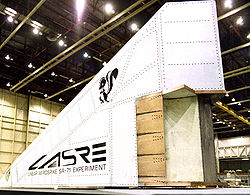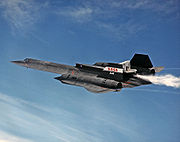
LASRE
Encyclopedia


NASA
The National Aeronautics and Space Administration is the agency of the United States government that is responsible for the nation's civilian space program and for aeronautics and aerospace research...
's Linear Aerospike SR-71 Experiment which took place at the Dryden Flight Research Center
Dryden Flight Research Center
The Dryden Flight Research Center , located inside Edwards Air Force Base, is an aeronautical research center operated by NASA. On March 26, 1976 it was named in honor of the late Hugh L. Dryden, a prominent aeronautical engineer who at the time of his death in 1965 was NASA's deputy administrator...
at Edwards Air Force Base
Edwards Air Force Base
Edwards Air Force Base is a United States Air Force base located on the border of Kern County, Los Angeles County, and San Bernardino County, California, in the Antelope Valley. It is southwest of the central business district of North Edwards, California and due east of Rosamond.It is named in...
, California
California
California is a state located on the West Coast of the United States. It is by far the most populous U.S. state, and the third-largest by land area...
, until November 1998. The experiment sought to provide flight data to help Lockheed Martin
Lockheed Martin
Lockheed Martin is an American global aerospace, defense, security, and advanced technology company with worldwide interests. It was formed by the merger of Lockheed Corporation with Martin Marietta in March 1995. It is headquartered in Bethesda, Maryland, in the Washington Metropolitan Area....
validate and tune the computational predictive tools used to determine the aerodynamic performance of the X-33
Lockheed Martin X-33
The Lockheed Martin X-33 was an unmanned, sub-scale technology demonstrator suborbital spaceplane developed in the 1990s under the U.S. government-funded Space Launch Initiative program. The X-33 was a technology demonstrator for the VentureStar orbital spaceplane, which was planned to be a...
lifting body and linear aerospike engine combination and to lay groundwork for a future reusable launch vehicle.
LASRE was a small, half-span model of the X-33's lifting body with eight thrust cells of an aerospike engine
Aerospike engine
The aerospike engine is a type of rocket engine that maintains its aerodynamic efficiency across a wide range of altitudes through the use of an aerospike nozzle. It is a member of the class of altitude compensating nozzle engines. A vehicle with an aerospike engine uses 25–30% less fuel at low...
, rotated 90 degrees and mounted on the back of an SR-71 Blackbird
SR-71 Blackbird
The Lockheed SR-71 "Blackbird" was an advanced, long-range, Mach 3+ strategic reconnaissance aircraft. It was developed as a black project from the Lockheed A-12 reconnaissance aircraft in the 1960s by the Lockheed Skunk Works. Clarence "Kelly" Johnson was responsible for many of the...
aircraft, to operate like a kind of "flying wind tunnel
Wind tunnel
A wind tunnel is a research tool used in aerodynamic research to study the effects of air moving past solid objects.-Theory of operation:Wind tunnels were first proposed as a means of studying vehicles in free flight...
." The experiment focused on determining how a reusable launch vehicle's engine plume would affect the aerodynamics of its lifting body shape at specific altitudes and speeds reaching about 750 miles per hour (335 meters per second or 1207 km/h). Design refinements looked to minimize the interaction of the aerodynamic flow with the engine plume, which could create drag.
The aircraft completed seven research flights. Two initial flights were used to determine the aerodynamic characteristics of the LASRE apparatus on the back of the aircraft. The first of those two flights occurred October 31, 1997. The SR-71 took off at 8:31 a.m. PST. The aircraft flew for one hour and 50 minutes, reaching Mach 1.2 and an altitude of 33,000 feet (10,000 m) before landing at Edwards at 10:21 a.m. PST, validating the SR-71/pod configuration.
Five later flights focused on the experiment; two were used to cycle gaseous helium and liquid nitrogen
Liquid nitrogen
Liquid nitrogen is nitrogen in a liquid state at a very low temperature. It is produced industrially by fractional distillation of liquid air. Liquid nitrogen is a colourless clear liquid with density of 0.807 g/mL at its boiling point and a dielectric constant of 1.4...
through the experiment to check its plumbing system for leaks and to check engine operation characteristics. The first of these flights occurred March 4, 1998. The SR-71 took off at 10:16 a.m. PST. The aircraft flew for one hour and fifty-seven minutes, reaching Mach 1.58 before landing at Edwards at 12:13 p.m. PST.
During three more flights in the spring and summer of 1998, liquid oxygen was cycled through the engine. In addition, two engine hot firings were conducted on the ground. Researchers decided not to do a final hot-fire flight test because of the liquid oxygen leaks in the test apparatus. The ground firings and the airborne cryogenic gas flow tests provided enough information to predict the hot gas effects of an aerospike engine firing during flight.
External links
- Image gallery

